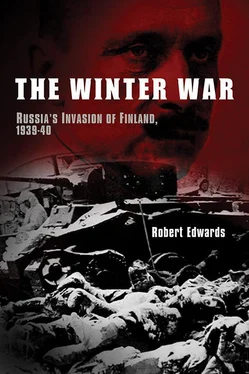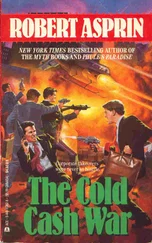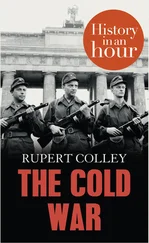It is a measure of the success enjoyed by Mannerheim’s persistent agitation that Holsti—perhaps tactlessly—enquired about the possibility of arms sales to Finland, at which point Yartsev replied that such matters were feasible, provided the ‘guarantees’ to which he had alluded were met, but about which he could speak no further. Finally, he added, neither Deravianski nor anyone else from the Soviet legation should know about this rather one-sided conversation. Politely, Holsti showed him out.
Yartsev went immediately to Moscow, reported, and proceeded then to Stockholm, where he had a detailed conversation with Foreign Minister Rickard Sandler. Unsurprisingly, the subject was the Åland question; despite Sweden’s insistence upon the destruction of the Tsarist fortifications, the archipelago had lost little of its strategic importance, merely reverted to being a brown-field site for a military developer. For the Swedes, however, it was bad enough that the Ålands were Finnish territory, so the prospect of Soviet hegemony over them was a clear anathema; Napoleon had been rather stating the obvious when he had said that in the hands of a great power, the Ålands were a ‘loaded pistol aimed at Stockholm’.
Despite Yartsev’s faintly theatrical injunctions to secrecy, he had not kept silent on the matter elsewhere in Finland. He had, apparently upon his own initiative, talked at length to at least one staff officer, General Sihvo, as well as Prime Minister Cajander’s assistant Arvo Inkalä, not to mention Moscow’s fellow-traveller, the eccentric left-wing playwright Hella Wuolijoki (nee Ella Murrik), who had ‘form’ in this matter. [20] Wuolijoki was totally deranged, in the view of some, but certainly a Comintern agent as well as queen bee of the limousine left. An Estonian by birth, she also wrote under the pseudonym of Juhani Tervapää. She worked with Bertholt Brecht, while he lived with her in 1940 at her grand country house, the Villa Marlebäck, in the village of Iitti, north-west of Helsinki. She had been married, briefly, to the Social Democrat M. P. V. Wuolijoki, who was a close associate of Kuusinen, and whom Tanner had known as well as he wished.
In the latter case, Yartsev was rather singing to the choir, as Wuolijoki marked perhaps the most obvious link, not only with O. V. Kuusinen the thwarted Bolshevik exile, but with a wider Communist audience outside Finland. [21] One of Kuusinen and V. Wuolijoki’s first cooperations had been the translation of ‘the Internationale’ into Karelian, for repetitive broadcast into Finland from the Soviet Union.
Her sister Salme was married to Rajani Palme Dutt, the Swedish/Indian theoretician who ran (in uneasy alliance with the ebullient Harry Pollitt), the British Communist Party. Clearly, the ground was being prepared; an inveterate gossip anyway, Wuolijoki could be expected to pass on Yartsev’s obiter dicta to her sister, to augment the Comintern’s instructions, which, as this crisis developed, would become less and less consistent.
Arvo Inkalä chose to exercise his own leisurely discretion in bringing the matter of Yartsev’s approaches to his boss’s attention and two months later, at the end of June, Cajander saw the Russian, apparently with little outcome, save to arrange a meeting for 11 July, after which Väinö Tanner was informed of the affair.
Tanner, who met Yartsev on 30 July, was important not in the sense that he held relevant office (he was minister of finance at the time) but because of his leadership role within the Social Democrats. In truth Tanner, in keeping with his remit (and his instincts as a trader), was naturally keener to discuss business, which was difficult on two grounds: firstly, that trade talks could only spring from political ones and second, Yartsev knew little or nothing about the subject, save that it was at present almost nonexistent. [22] Both Tanner and Ryti studied trade and commerce with an all-consuming passion; Tanner in order to strengthen the co-operative movement land stamp hard on any poujadiste tendencies which might emerge elsewhere—he had little time for shopkeepers) and Ryti as a theoretical, even philosophical matter. Both men clearly missed the point concerning Soviet advances on this—trade, like everything else, was but a single piece of a very complex ideological jigsaw.
It was clear that Yartsev’s role was that of herald rather than principal and that he enjoyed an almost unique, but rapidly closing window of opportunity—although personally he was probably under less immediate pressure, as a serving NKVD officer, than certain other Soviet diplomatists, many of whom sat in paralysis, dreading recall to Moscow ‘for consultations’ and to share the fate of so many others at that time. [23] A good example was Corps Commander Vitovt Puma, Soviet military attaché in London, recalled in September 1936 and executed in the same week as Tukhachevski.
What is perhaps startling, given the proximity of the two countries, is the extraordinary poverty of Soviet intelligence concerning the nature, priorities and ambitions of the Finns. It is not hard to imagine—given the tectonic shift in relations between the ruling elite in Moscow and the rest of the Party globally, the result of which was a blood-letting on an unprecedented scale—that there would be a natural instinct on the part of the interested reporters of these events to spin the realities somewhat. But the Soviet assessment of conditions in Finland fell so wide of the mark that they might well have been referring to another country entirely. The reason for this was simple—the Communist Party was an illegal organization in Finland—its nearest official representative, Arvo Tuominen, lived in exile in Stockholm.
Much of the Soviet attitude had its roots in a doctrinaire interprétation of the chain of events since Finnish independence, ratified at Tartu. In the wake of that, Stalin [24] Or more probably Otto Kuusinen, who was a prolific, if talentless, ghost writer.
had written:
The revolt of the Finnish workers and agricultural labourers… demonstrated the completed isolation of the government from their own masses. Utterly defeated, the government were obliged to appeal for aid against their own workers and peasants to the imperialists of western Europe, the age-long oppressors and exploiters of the small nations of the world.
The very fact that Stalin, as Commissar for Nationalities, [25] A more twenty first-century job title would be Minister of Diversity within the Soviet Union.
had his name on the treaty reflected the reality of that event. His piece, which appeared in Pravda at the end of 1920, reflected a dutiful disappointment at the Soviet Union’s inability to foment a successful revolution in Finland. As the thwarted fellow-travellers trailed back to Russia, many were enlisted as front-line Comintern propagandists in what now was to become the major front of Soviet diplomacy in the West: the recreation of the territorial status quo of the Tsarist state in the light of the relatively serious failure in Finland and the catastrophe of Poland.
The most well-known Finn among these exiles was Otto Ville Kuusinen, who swiftly rose within the executive committee of the Comintern, developing a life-saving line in humourless toadying which would allow him, adroitly, to survive successive purges. [26] He was General Secretary by 1923 (his name appears on the famed Zinoviev letter—he may even have written it).
He was in constant and close contact with Wuolijoki and (via her sister Salme) Dutt.
Naturally, given the arms-length nature of both commercial and diplomatic contact, the Soviet justification for Soviet-Finnish relations needed to be spun somewhat. Rather than concede that independent Finland had little use for the Soviet project, and was prospering very well on its own, the orthodoxy developed that not all was well; another fugitive Finn, Yrjö Eljas Sirola, People’s delegate for foreign affairs in the short-lived administration, had announced to the sixth Congress of the Comintern in 1928:
Читать дальше











